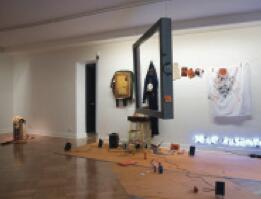Palmario
D 21, Santiago
Rather than revealing a point of view on the current Argentine art scene, Palmario introduces us into a universe shared by a curator and artist –Ana Gallardo– and the group of artists belonging to different generations that she convened: Marcela Astorga, Mercedes Azpilicueta, Roxana Buttazoni, Marina de Caro, Graciela Hasper, Irina Kirchuk, Catalina León, Mariela Scafati + Colectivo de lo Ausente, and Elisa Strada. Bonds of affection constitute the first connection. Perhaps for this reason, the tour of this space − a roomy apartment in the municipality of Providencia − becomes an intimate experience, despite the experimental nature and the perplexity characteristic of contemporary strategies. There are different techniques and spatial solutions: installation, painting, graphic art, video, murals and site-specific works.

Indeed, the whole exhibition becomes a sort of site-specific work in which no individual component appears to be entirely solved; rather, each seems to be exploring and showing a personal instant engaged in a dialogue with the surrounding elements. The paintings exhibited have been executed on nonconventional supports, such as cardboard or acetate, and the installations are, mainly, objects which have been deposited, objects which play with the status of the ready made. A screening shows a ride on bicycle through the city; some cleaning cloths stained with paint, an empty frame and diverse utensils arranged in a corner are reminiscent of an artist’s studio, while a series of painted papers fold over, spread out, and become reattached to the wall; below this, a strange woolen doll, and in another exhibition hall, a mural featuring blue cutouts configures an abstraction of optical effects that reveals local references. These and other works appear to be vestiges left on some wall or across the floor, where the theme of identity flows in a lucid and ludic curatorial exercise, without discursive ostentations, more inclined towards poetry.



